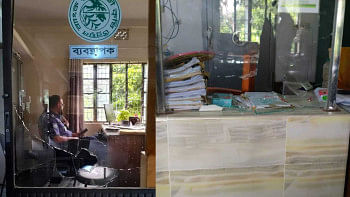We should demand the minimum historical flow in the Teesta

Engr. M. Inamul Haque, Chairman, Institute of Water & Environment, Dhaka talks with Shahriar Feroze of The Daily Star about the disputes relating to the trans-boundary rivers flowing through India and Bangladesh.
The Daily Star (TDS): Against the backdrop of low-flow along Teesta River's Dalia point in Bangladesh, what do you think are the main causes?
M. Inamul Haque (MIH): There are two main causes for lowering of the flow of Teesta River: (1) Placing of obstructions in the tributaries of the Teesta River in Sikkim to stop their winter flows coming down to the plains. The Sikkim Tourism department is building about 40 dams on its rivers, and other infrastructures, to make the state 2nd to Goa in India as a tourist destination. Visiting the South Asia Network on Dams, Rivers & People website, we shall get to know that there are 5 existing dams, 4 ongoing and 31 proposed in Teesta upper catchment. These are termed as 'run-off the river' dams, which are not supposed to affect the river flows. But 'run-off the river' concept is possible only in rainy season when water is abundant. In dry season, water storage and evaporation loss from the reservoirs reduce the downstream flows substantially. So, these dams in the hills are killing the Teesta River downstream.
(2) The second major cause is, whatever water comes down from the hills of Sikkim is stopped by the Gazaldoba Barrage and diverted through a link canal to the Upper Mahananda River. The Upper Mahananda River falls in the Mechi River in Bihar, which goes through the Fulhar River and reaches the Ganga River upstream of Farakka Barrage. By this diversion, the River Interlinking Project is being implemented through canals # 1 & 12. The Teesta water we get in Bangladesh is the regenerated water downstream of Gazaldoba Barrage and the added flow of the Upper Dharla River arriving from the Duars of West Bengal.
India has an irrigation project depending on Teesta waters to cover about 9.22 lakhs hectares of land in Cooch Behar, Jalpaiguri, and Darjeeling, Uttar Dinajpur, Dakshin Dinajpur and Maldah districts. By now, more than 1 lakh hectares of land have come under its coverage, and it is increasing every year. This is the third reason for reducing the Teesta waters flowing towards Bangladesh.
TDS: What should be the minimal amount of water to keep our irrigation system functional?
MIH: In the 37th meeting of the JRC in Delhi, in March 2010, the Bangladesh Water Resources Minister Ramesh Chandra Roy demanded 50-50 distribution of the Teesta water at Gazaldoba point. At that time he expressed satisfaction that we were getting 3,500 cusec of water without asking, and said it could be more. In January 2011, at the secretary level meeting, Bangladesh demanded 8,000 cusec and India 21,000 cusec from the Teesta waters. Together, the demands become 29,000 cusec when the lowest flow in the river cannot be more than 10,000 cusec.
In my opinion, we should demand the minimum historical flow in the Teesta River towards Bangladesh, which is not less than 4,500 cusec by any argument. This amount should be primarily to save the life of the river. A part of this amount can be diverted by the Teesta Barrage for our irrigation system.
TDS: As signing a concrete accord is not possible any time soon, is there an alternate short term solution?
MIH: According to the PM's advisor Mashiur Rahman, the accord on the table was to measure the Teesta flow for 17 years, and the agreement was to be signed after that. It appeared in the The Daily Star of September 3, 2011. How can be that an accord? Measuring the Teesta flow for 17 years was nothing but eyewash. It was to befool, not to benefit, the people of Bangladesh. Well, the short term accord can be to distribute the Teesta water arriving at the upstream of the Gazaldoba Barrage on 50-50 basis. This accord should ensure that no transfer of water from the Teesta basin to the Mechi basin takes place.
TDS: The confusion regarding the quantity of water Teesta river carries has been prevailing for a long time. How can the actual quantity of water in the river be measured?
MIH: The Ganga water distribution accords (1977 & 1996) are based on its historical flow since 1948. Teesta has similar records. The present Teesta flow can be measured at four points, (1) the Anderson Bridge on the Siliguri Gangtok highway to measure water arriving from Sikkim, (2) the upstream of Gazaldoba Barrage to measure water available for distribution, (3) Domohoni Bridge on Jalpaiguri Mainaguri Road & Railway to measure the additional flow arriving from Duars, and (4) upstream of the Teesta Barrage to measure flow arriving in Bangladesh.
TDS: According to information, the usual flow is already being affected by the 5 existing and 4 ongoing dams in the Teesta upper catchment. What would be the likely situation if more dams are built?
MIH: As more dams are built, very low flow shall arrive from Sikkim in the Teesta River from November to March, or it could stop. From April, flows arriving from the snowmelt waters of the Himalayas are to be spilled over the Sikkim dams. In absence of a 50-50 sharing accord at Gazaldoba point, almost no Teesta water shall flow down to Bangladesh until June.
TDS: If water of a river is to be shared on historical nature of flow then what should we do in case a country artificially alters its natural course of flow?
MIH: Articles 2a, 3(4), 5, 6(1), 6(3) etc., of the UN Watercourse Convention of 1997 ensures the rights of co-riparian countries of the common rivers. Bangladesh should immediately ratify this convention, and pursue India diplomatically to ratify it. In the meantime, we should collect all information from different sources (not waiting for or depending on the official information arriving from India) to argue on a strong basis. Simultaneously, we the activists of Bangladesh, should contact and give support to the activists of India who are opposing dams and diversion of rivers inside their country for environmental reasons.
TDS: What would be your suggestion for securing a confirmed deal regarding stakeholders of Teesta or any river for that matter?
MIH: India has become a conglomerate of many states, which are exercising their powers on local issues beyond their official jurisdiction. Paschimbanga is exercising its power on Teesta waters. Assam is introducing its own local time, different from the rest of India. We have 7 sister states and Paschimbanga as our neighbours in India. In this prevailing situation, our diplomacy should extend to the state level also, maybe through some unofficial channels. On bilateral matters between sovereign states, if diplomacy deals with the interest of the people of both the countries, it shall win. Sikkim, Paschimbanga and Bangladesh should have common interests on the Teesta River; Assam and Bangladesh on the Brahmaputra River; Assam, Manipur and Bangladesh on the Barak River; Tripura and Bangladesh on the Khowai, Monu, Gomti and Muhuri Rivers; Meghalaya and Bangladesh on the Someswari, Rakti, Chalti, Dhala and Sari Rivers; etc. We should work in this line.

 For all latest news, follow The Daily Star's Google News channel.
For all latest news, follow The Daily Star's Google News channel. 



Comments